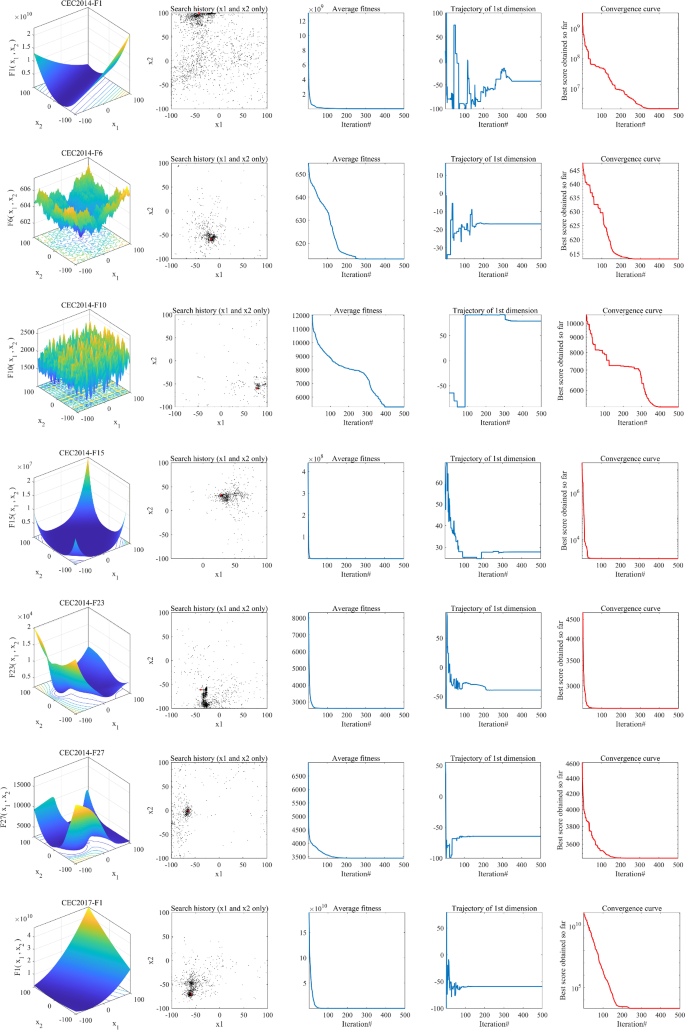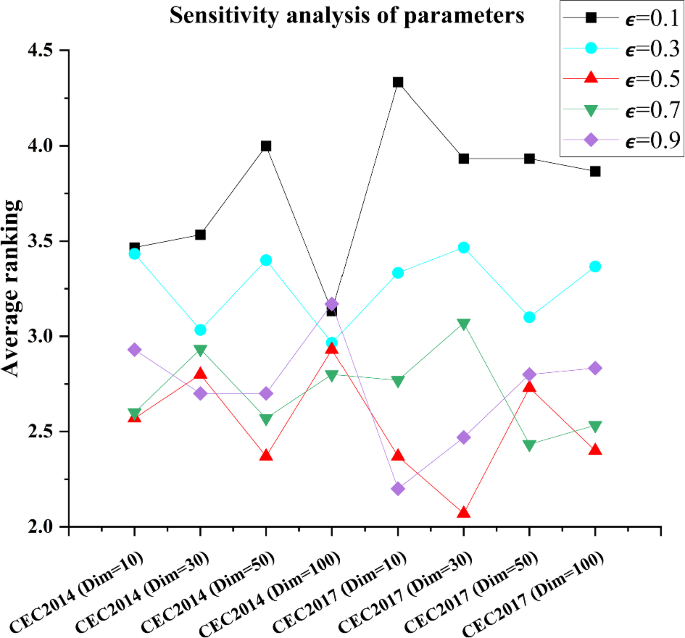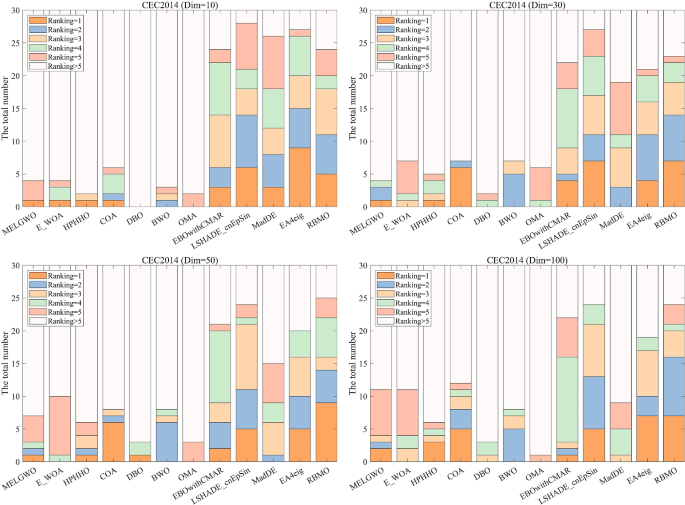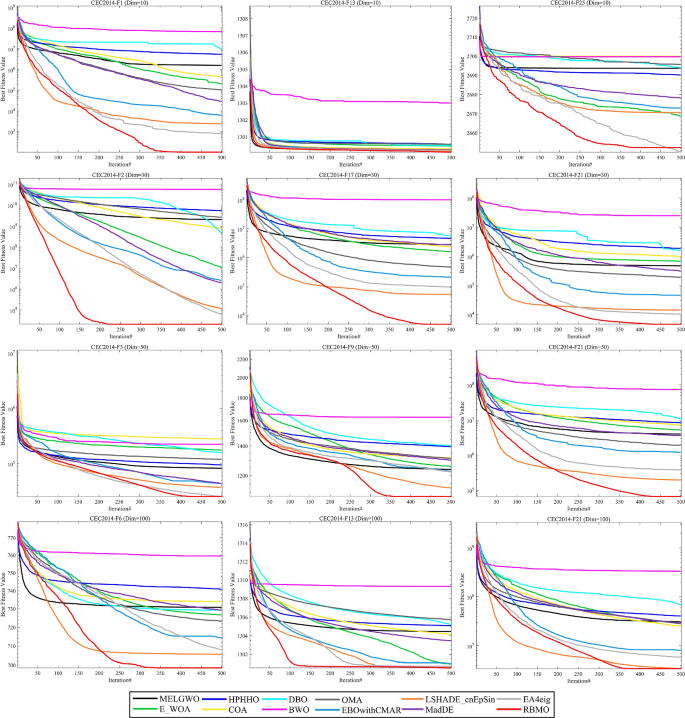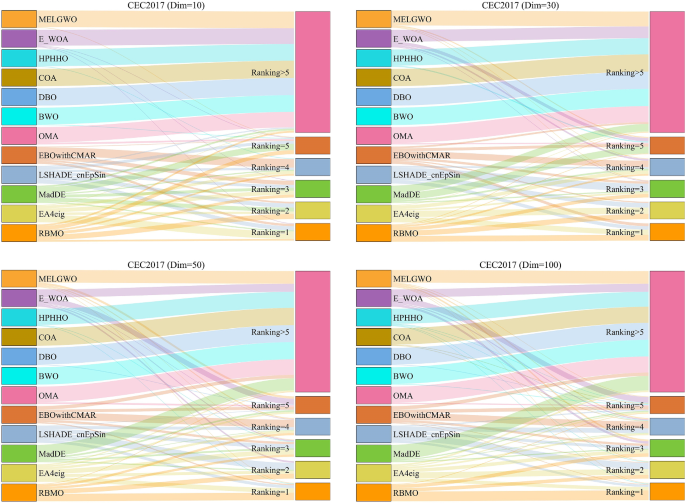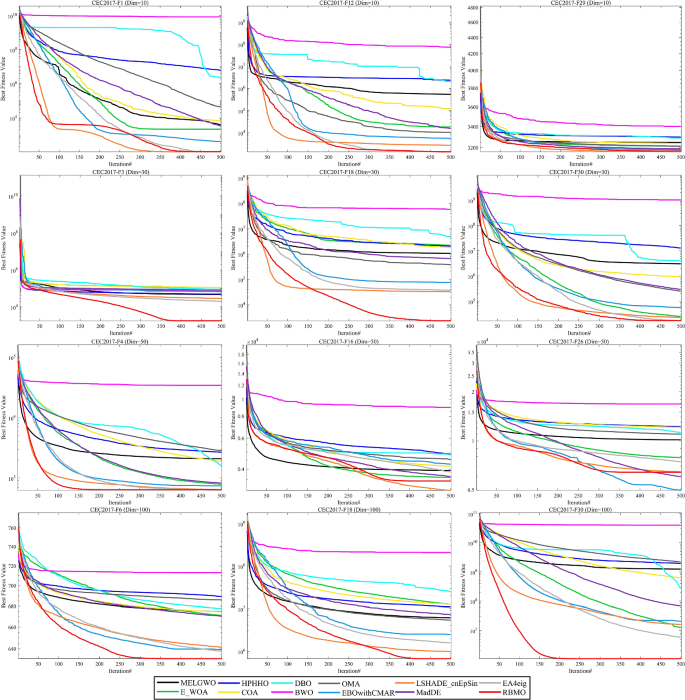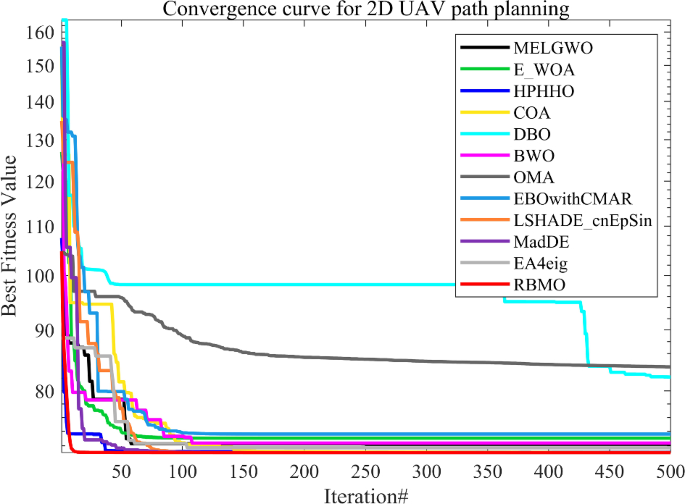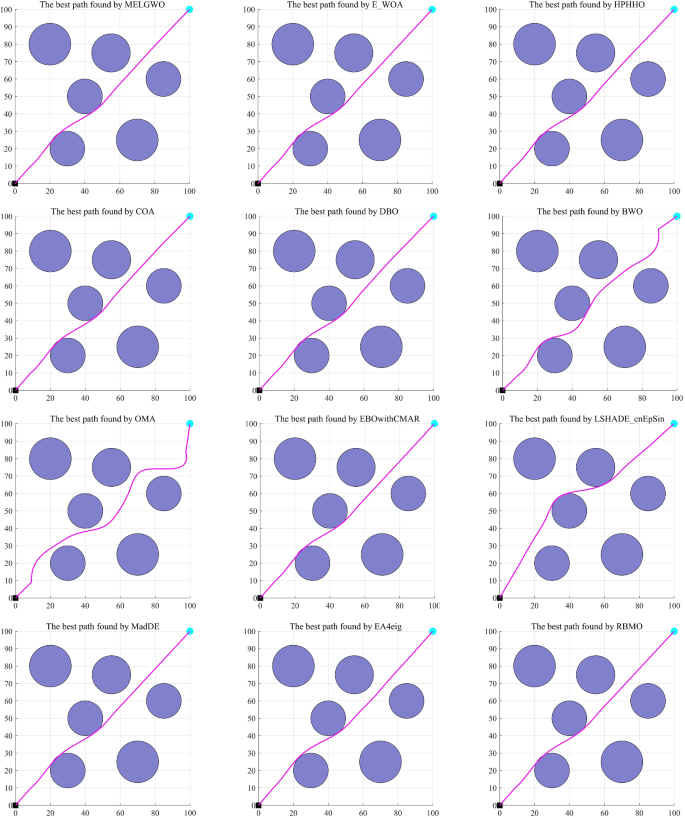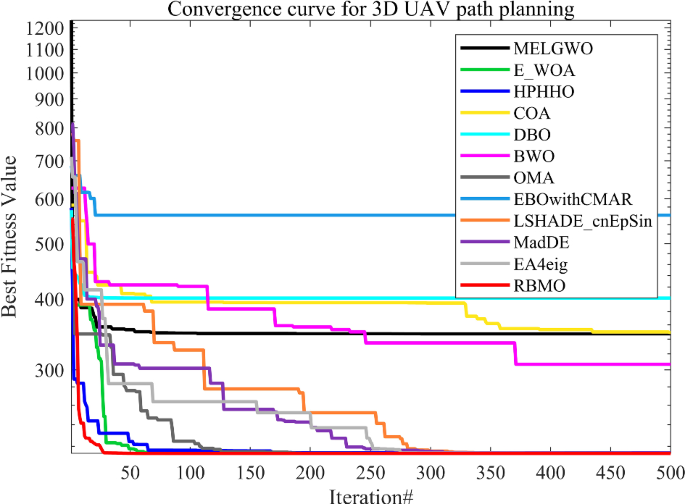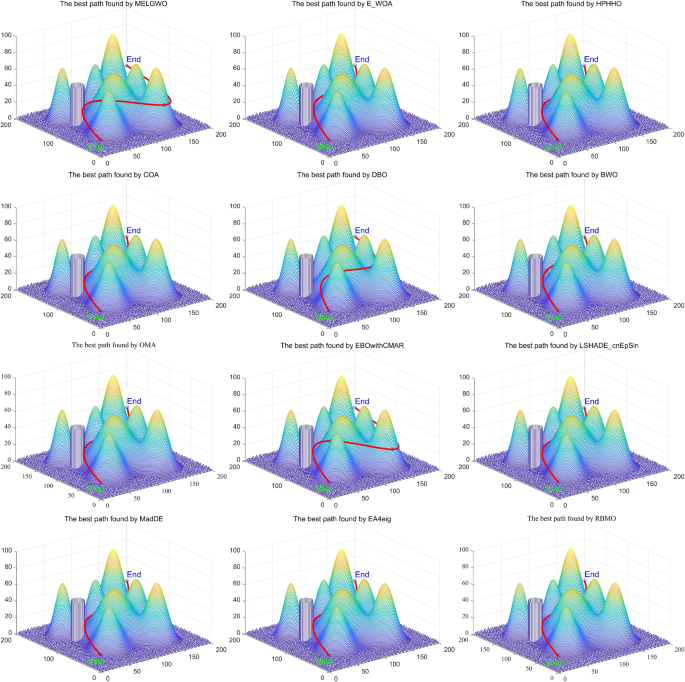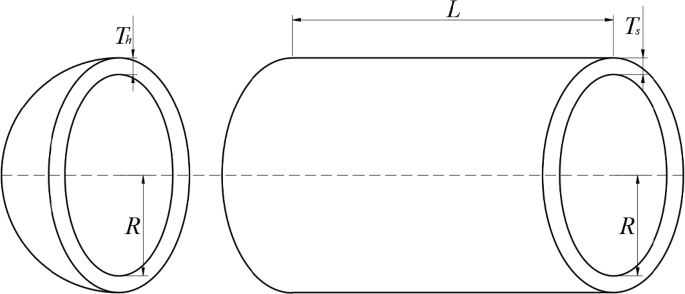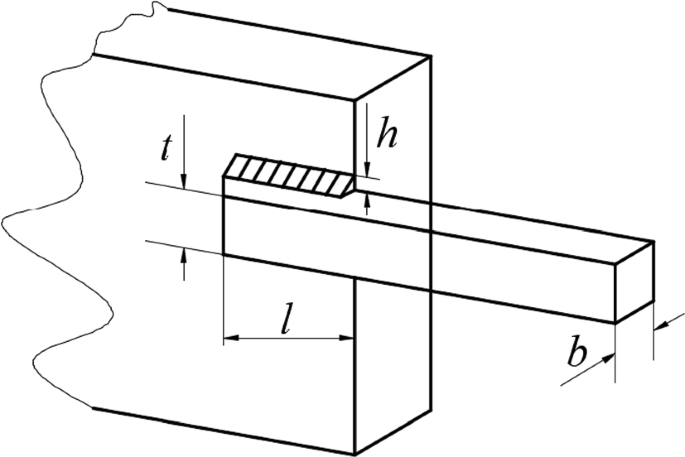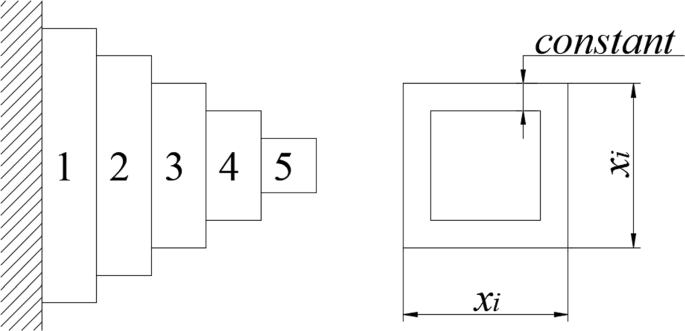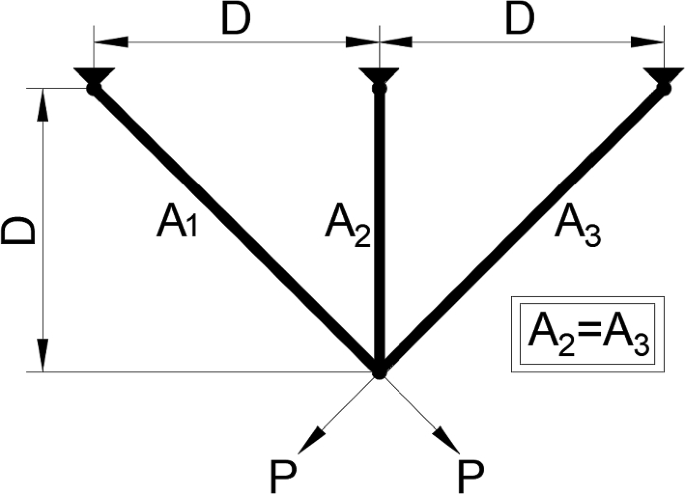Abstract
Numerical optimization, Unmanned Aerial Vehicle (UAV) path planning, and engineering design problems are fundamental to the development of artificial intelligence. Traditional methods show limitations in dealing with these complex nonlinear models. To address these challenges, the swarm intelligence algorithm is introduced as a metaheuristic method and effectively implemented. However, existing technology exhibits drawbacks such as slow convergence speed, low precision, and poor robustness. In this paper, we propose a novel metaheuristic approach called the Red-billed Blue Magpie Optimizer (RBMO), inspired by the cooperative and efficient predation behaviors of red-billed blue magpies. The mathematical model of RBMO was established by simulating the searching, chasing, attacking prey, and food storage behaviors of the red-billed blue magpie. To demonstrate RBMO’s performance, we first conduct qualitative analyses through convergence behavior experiments. Next, RBMO’s numerical optimization capabilities are substantiated using CEC2014 (Dim = 10, 30, 50, and 100) and CEC2017 (Dim = 10, 30, 50, and 100) suites, consistently achieving the best Friedman mean rank. In UAV path planning applications (two-dimensional and three − dimensional), RBMO obtains preferable solutions, demonstrating its effectiveness in solving NP-hard problems. Additionally, in five engineering design problems, RBMO consistently yields the minimum cost, showcasing its advantage in practical problem-solving. We compare our experimental results with three categories of widely recognized algorithms: (1) advanced variants, (2) recently proposed algorithms, and (3) high-performance optimizers, including CEC winners.
Similar content being viewed by others
Avoid common mistakes on your manuscript.
1 Introduction
With the rapid advancement of UAV technology, they have emerged as a groundbreaking tool in modern technology, offering unprecedented opportunities and challenges in fields such as military, marine remote sensing, environmental monitoring, disaster response, and logistics (Wu et al. 2023). In the pursuit of these tasks, the 3D path planning problem for UAV has become a prominent research focus. Traditional path planning methods often fall short in three−dimensional environments. Swarm intelligence algorithms, as a heuristic approach simulating collective behaviors in nature, have shown great promise in addressing the 3D path planning problem for UAV (Wang et al. 2023). By emulating behaviors of natural groups like ant colonies and bird flocks, swarm intelligence enables high levels of cooperation among group members. The introduction of swarm intelligence algorithms in 3D UAV path planning not only enhances planning efficiency but also ensures the safety and stability of paths, providing a higher degree of controllability for UAV movements in three−dimensional space (Gugan and Haque 2023).
The optimization problem is to find a set of decision variables to maximize or minimize the objective function under certain constraints (Pozna et al. 2022; Zhou et al. 2022). With the increasing complexity of real-world optimization Dengproblems, the performance of deterministic algorithms is significantly reduced. Stochastic algorithms show good performance in dealing with such complex problems. The metaheuristic algorithm is a stochastic algorithm that performs well in complex nonlinear problems. Therefore, metaheuristic algorithms are widely used to solve practical problems, such as feature selection (Said et al. 2023; Talapula et al. 2023), scheduling (Fontes et al. 2023), identification (Minh et al. 2022), cloud computing (Attiya et al. 2022), neural networks (Jain et al. 2022), engineering problems (Abdel-Basset et al. 2023; Zhu et al. 2024), classification (Pashaei and Pashaei 2022), global optimization (Alrahhal and Jamous 2023; Seyyedabbasi and Kiani 2023), medicine data classification (Zhong et al. 2023), diabetic retinopathy detection (Prabhakar et al. 2024), etc. The metaheuristic algorithm has four advantages in solving these complex nonlinear problems (Mirjalili et al. 2014): simplicity, flexibility, derivation-free mechanism, and local optima avoidance.
Generally, we divide metaheuristic algorithms into four categories (Abualigah et al. 2021): Swarm Intelligence (SI) algorithms, Physics-based Algorithms (PhA), Evolutionary Algorithms (EA) and Human-based algorithms. The swarm intelligence algorithm is the most representative metaheuristic algorithm, which solves problems by simulating group behavior in nature (Smith 2000). For example, Kennedy et al. (Kennedy and Eberhart 1995) proposed the Particle Swarm Optimization (PSO) algorithm by imitating the process of bird swarms foraging. The PSO is the most popular swarm intelligence algorithm and has been widely studied by scholars. Physics-based algorithms often mimic physical rules and chemical reactions. For instance, Kirkpatrick et al. (Kirkpatrick et al. 1983) proposed a simulated annealing algorithm inspired by the metal annealing process. Evolutionary algorithms are based on biological principles (Bäck and Schwefel 1993). For example, Holland (Holland 1992) proposed a Genetic Algorithm (GA) based on Darwin’s evolution theory. Human-based algorithms imitate human cognitive and behavioral processes. For instance, Rao et al. (Rao et al. 2011) proposed a Teaching-Learning-Based Optimization (TLBO) by simulating the classroom teaching process. Since we propose a swarm intelligence algorithm, we mainly introduce the swarm intelligence algorithm and its application.
In the past time, the PSO algorithm has been used to deal with many practical problems, for example, task scheduling (Alsaidy et al. 2022), wireless sensor networks (Wang et al. 2018), image enhancement (Zhang et al. 2023b) and other problems. Karaboga et al. (Karaboga and Basturk 2008) proposed an artificial bee colony (ABC) inspired by bee population behavior. It has been used to solve the clustering of wind power scenarios (Yao et al. 2022), prediction of sports economic development (Liu and Song 2022), flexible job-shop scheduling (Long et al. 2022), image threshold segmentation (Huo et al. 2022) and so on. Grey Wolf Optimizer (GWO) is an optimization algorithm developed by Mirjalili et al. (Parizi et al. 2020) to simulate the hunting behavior of grey wolf groups. It has been successfully applied in 5G frequency selection surface design (He et al. 2022), dam deformation prediction (He and Wu 2023), path planning for mobile robots (Hou et al. 2022), predictive current control (Mahmoudi et al. 2022), Capacitor Placement in Radial Distribution Systems (Jayabarathi et al. 2022) and others. Mirjalili et al. (Mirjalili 2015) proposed a Moth-flame optimization algorithm (MFO) based on the moth navigation method in nature, which has been used to solve automatic parking path optimization (Chen et al. 2022), parameter estimation of induction motor (Ma et al. 2022), UAV formation path planning (Wu et al. 2023) and so on. Yu et al. (Yu & Li 2015) proposed the social spider algorithm by the foraging behavior of social spiders in nature, which has been widely used to solve practical problems, including cloud detection in satellite images (Gupta and Nanda 2022), line balancing (Liang et al. 2023), efficient data dissemination in VANET (Shankar et al. 2022), classify microscopic biopsy images of cancer (Balaji and Chidambaram 2022), and job scheduling (Kuppusamy et al. 2022). Parizi et al. (Morteza et al. 2020) introduced the Woodpecker Mating Algorithm (WMA) to simulate the mating behavior of woodpeckers, successfully applied in various domains, including neural networks (Parizi et al. 2021b), software development effort estimation (Parizi et al. 2021a), economic load dispatch (Karimzadeh et al. 2021), and other problems (Gonga and Parizi 2022; Zhang et al. 2023a). Moreover, many high-performance algorithms have been proposed recently, for example, the Dwarf Mongoose Optimization algorithm (DMO) proposed by Agushaka et al. (Agushaka et al. 2022) based on the foraging behavior of the dwarf mongoose. Zamani et al. (Nadimi-Shahraki and Zamani 2022) came out with Starling Murmuration Optimizer (SMO) by imitating Starlings’ behaviors. Inspired by the particular mating behavior of snakes, Hashim et al. (Hashim and Hussien 2022) proposed Snake Optimizer (SO). Zhong et al. proposed Beluga Whale Optimization (BWO) by simulating the behaviors of beluga whales. Ezugwu et al. (Ezugwu et al. 2022) proposed Prairie Dog Optimization (PDO) by impersonating the behavior of prairie dogs. Jia et al. (Jia et al. 2023) proposed the Crayfish Optimization Algorithm (COA) by simulating the summer escape behavior, competition behavior, and foraging behavior of crayfish. Deng et al. (Deng and Liu 2023b) emulated the sublimation and melting behavior of snow to introduce the Snow Ablation Optimizer (SAO). Tian et al. proposed the Snow Geese Algorithm (SGA) by simulating the migration behavior of snow geese (Tian et al. 2024). The algorithm Greylag Goose Optimization (GGO), proposed by El-kenawy et al. (El-kenawy et al. 2024), is inspired by the flying habits of grey geese. These advanced algorithms are widely used in different optimization problems, and most have achieved varying degrees of success (Akinola et al. 2022; Fu et al. 2022; Li et al. 2022; Nadimi-Shahraki et al. 2023; Rizk-Allah et al. 2023).
In particular, our research team has achieved some positive results in optimizing algorithms. For example, we have proposed a new imbalance fault diagnosis framework based on an MFO-optimized LS-SVM classifier and successfully applied it to limited and complex bearing data (Wei et al. 2020). Based on innovative updating rules and opposition-based learning, we proposed a modified EO (Fan et al. 2021). We introduced self-adaptive into the marine predator algorithm and applied it to framework and engineering problems (Fan et al. 2022). For the grey wolf optimizer, we proposed BGWO (Fan et al. 2021b) and AGWO (Ma et al. 2022) by giving the leader wolf hearing and flying abilities, respectively. The latest research achievements of our team include IDMO (Fu et al. 2023) and MENGO (Li et al. 2023). The No Free Lunch (NFL) theorem (Wolpert and Macready 1997) states that no optimization algorithm can solve all optimization problems effectively. Therefore, it is still challenging to find a new efficient metaheuristic algorithm.
Based on our team’s previous research and NFL incentives, in this work, we propose a new metaheuristic algorithm called Red-billed Blue Magpie Optimizer (RBMO) for numerical optimization, engineering design problems, and UAV path planning. It overcomes the problems of initialization sensitivity, premature convergence and stagnation in the local optimum of most algorithms. RBMO is an algorithm based on swarm intelligence, inspired by the hunting process of the red-billed blue magpie, which includes searching, attacking prey, and food storage. The red-billed blue magpie is a flexible and adaptable predator. It primarily feeds on fruits, insects, and small vertebrates, exhibiting a diverse hunting behavior. These magpies usually move in small groups or clusters, aiding them in locating food resources more efficiently. Collective action enhances their search effectiveness. Additionally, they obtain food from both the ground and trees. Finally, they store food in tree holes or other suitable locations for future consumption, ensuring a reliable food source during times of scarcity. The hunting behavior of the red-billed blue magpie underscores its flexibility as a predator, proficient in employing a range of strategies and techniques to secure food. Furthermore, it exhibits social and cooperative tendencies. The mathematical model of RBMO encompasses both exploration and exploitation phases. RBMO’s performance was evaluated using the CEC2014 and CEC2017 test suites. Moreover, RBMO was applied to address five engineering design problems and UAV path planning. Comparative experiments reveal that the proposed method outperforms popular metaheuristic approaches, showcasing significant application potential.
The rest of this paper is organized as follows: Sect. 2 describes the RBMO inspiration and mathematical model. In Sect. 3, we conduct the numerical experiment and analyze them in detail. In Sect. 4, we apply RBMO to solve 2D and 3D UAV path planning. In Sect. 4, we apply the RBMO to address five engineering design problems, providing a comprehensive analysis of both its strengths and weaknesses. Summarizes and prospects this work in Sect. 6.
2 The Red-billed blue magpie optimizer (RBMO)
2.1 Inspiration
The red-billed blue magpie is a bird mainly living in Asia, which is common in China, India, Myanmar, and other places (Wolpert and Macready 1997). As shown in Fig. 1, it depicts the red-billed blue magpie, which is characterized by its large size, bright blue feathers, and distinctive red mouth. The red-billed blue magpie mainly feeds on insects, small vertebrates, plants, etc., and has a relatively rich hunting behavior (Madge 2020). While foraging, the red-billed blue magpie employs a combination of jumping, ground-walking, and searching on branches to locate its food. The red-billed blue magpie exhibits heightened activity levels during the early morning and evening hours, often congregating in small groups of 2–5 or even exceeding 10 members. They engage in cooperative hunting efforts. For example, a magpie may find a fruit or an insect, and then it will attract other members to share. This allows them to work together to capture large insects or small vertebrates, and group action can help them overcome the defense mechanisms of prey. In addition, the red-billed blue magpie will also store some food for later use. To prevent theft by other birds or animals, they conceal food items in places like tree holes, tree forks, and rock crevices (Dronen and Tkach 2014; Guo et al. 2022). In general, the red-billed blue magpie is a flexible predator who acquires and stores food in a variety of ways, while also demonstrating sociality and cooperation in hunting behavior. Inspired by this, a new meta-heuristic algorithm RBMO is proposed. Next, we will provide detailed explanations of the mathematical models associated with these processes.
2.2 Population initialization
As in most algorithms, RBMO candidate solutions produced through Eq. (1). Stochastically produced within the constraints of the given problem and need to be updated after each iteration.
where \(X\) denotes the position of the search agent generated by Eq. 2, \(n\) represents the population size, and \(\text{d}\text{im}\) denotes the dimension of solving the problem.
where \(ub\) and \(lb\) are the upper and lower bounds of the problem, respectively, and \(Rand\) represents a random number from 0 to 1.
2.3 The mathematical model of RBMO
2.3.1 Search for food
In their quest for food, red-billed blue magpies typically operate in small groups (2 to 5) or clusters (more than 10) to enhance search efficiency. They employ various techniques such as jumping on the ground, walking, or scouring trees for food resources. This adaptability and flexibility enable red-billed blue magpies to employ diverse hunting strategies based on environmental conditions and available resources, ensuring access to an ample food supply. When small groups explore food, Eq. (3) is used, and Eq. (4) is utilized in cluster search.
where \(t\) demonstrates the current number of iterations, \({\varvec{X}}^{\varvec{i}}\left(t+1\right)\) represents the ith new search agent position, \(p\) signifies the number of red-billed blue magpies hunting in small groups, between 2 and 5, randomly selected from all searched individuals, Xm represents the mth individual chosen at random, \({\varvec{X}}^{i}\) denotes the ith individual, and \({\varvec{X}}^{rs}\left(t\right)\) denotes randomly selected search agents in the current iteration.
where \(q\) represents the number of search agents when the cluster explores food, between 10 and \(n\). Similarly, it is also randomly selected from the entire population.
2.3.2 Attacking prey
The red-billed blue magpie exhibits a high level of hunting proficiency and cooperation when pursuing prey. They employ tactics such as quick pecking, leaping to catch prey, or flying to capture insects. In instances of small group actions, the primary targets are typically small prey or plants. The corresponding mathematical model is presented in Eq. (5). When operating in clusters, red-billed blue magpies are capable of jointly targeting larger prey like large insects or small vertebrates. The mathematical representation for this behavior is outlined in Eq. (6). This predatory hunting behavior underscores the diverse strategies and skills possessed by the red- billed blue magpie, enabling it to be a versatile predator adept at securing food successfully in various scenarios.
where \({\varvec{\mathbf{X}}}^{food}\left(t\right)\) represents the position of the food, \(CF={\left(1-\left(\frac{t}{T}\right)\right)}^{\left(2\times \frac{t}{T}\right)}\), and \(Randn\) represents a random number used to generate a standard normal distribution (mean 0, standard deviation 1).
2.3.3 Food storage
In addition to searching for and attacking food, red-billed blue magpies also store excess food in tree holes or other concealed locations for future consumption, ensuring a steady food supply during scarcity. This process retains solution information, facilitating individuals in locating the globally optimal value. The mathematical model for this is presented in Eq. (7).
where, \({fitness}_{old}^{i}\) and \({fitness}_{new}^{i}\) represent the fitness values before and after the location update of the ith red-billed blue magpie, respectively.
To summarize, in RBMO, the optimization process commences by generating a random set of candidate solutions, referred to as populations. The search strategy of RBMO explores the suitable position, either a suboptimal or optimal solution, through repeated trajectories. The food storage phase enhances the exploration and exploitation abilities of RBMO. Finally, the RBMO search process concludes upon meeting the end criterion. It’s worth noting that the population size of the red-billed blue magpie differs during the hunting process, but the total number of small-scale populations and clusters remains similar. In this paper, we propose a coefficient \(\epsilon\) for the equilibrium population, setting it to 0.5. The pseudocode for RBMO is provided in Algorithm 1.
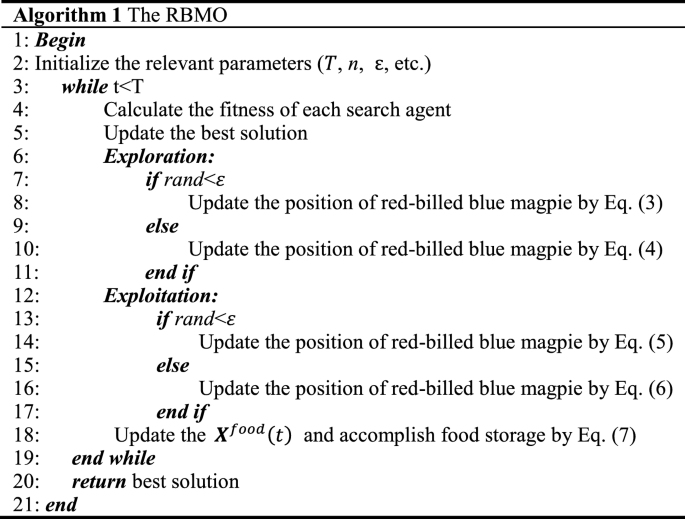
2.4 Computational complexity
In this section, we described the general computational complexity of RBMO. The computational complexity of RBMO typically depends on two rules: solutions initialization and the main algorithm functions, including calculating the fitness functions and updating the solutions. Assume that the number of search agents is \(n\), \(T\) denotes the maximum number of iterations, \(dim\) represents the dimension size of solving the problem, and \(O\left(n\right)\) demonstrates the computational complexity of the solutions’ initialization process. The computational complexity of the solutions’ updating process is \(O\left(T\times n\right)+O(2\times T\times n\times dim)\). It includes finding the best position and updating the position of all solutions. Accordingly, the total computational complexity of the proposed RBMO is \(O(n\times T\times (2\times dim+1\left)\right)\).
3 Numerical experiment
In this section, we evaluate the performance of RBMO on different function test suites. In order to verify the effectiveness of RBMO, we conducted convergence behavior analysis experiments. Meanwhile, numerical experimental results were compared with other advanced algorithms. Moreover, the scalability of RBMO has been demonstrated by solving largE − scale global optimization problems. Finally, two nonparametric tests, including the Wilcoxon signed rank test and the Friedman mean rank tests, were used to analyze the difference and overall performance of the competitors. All experiments were conducted on an Intel Core i7-12700 F computer with a 2.10 GHz CPU and 16 GB RAM using the MATLAB 2023a platform.
3.1 Benchmark test functions
The benchmark test function plays a crucial role in assessing the algorithm’s feasibility, offering an evaluation platform for testing and comparing various optimization algorithms. In this study,, we utilize the CEC2014 (Liang et al. 2013) and CEC2017 (Wu et al. 2016) test suites to assess the performance of the proposed RBMO, setting the dimensions to 30, 50, and 100, respectively. As the dimension increases, the number of locally optimal solutions also rises. Consequently, these test suites effectively scrutinize the algorithm’s global optimization capabilities and are among the most widely used suites. Detailed information regarding the CEC2014 and CEC2017 test suites are reported in Tables 1 and 2, respectively. Both suites encompass four types of functions: Unimodal, Multimodal, Hybrid, and Composition functions, which effectively validate the algorithm’s abilities in local exploitation and global exploration.
3.2 Competitor algorithms and parameters setting
We compare RBMO’s results to 11 other well-known algorithms, including MELGWO (Ahmed et al. 2023), E_WOA (Nadimi-Shahraki et al. 2022), HPHHO (Su et al. 2021), COA (Jia et al. 2023), DBO (Xue and Shen 2023), BWO (Zhong et al. 2022), OMA (Cheng and Sholeh 2023), EBOwithCMAR (Kumar et al. 2017), LSHADE_cnEpSin (Mohamed et al. 2017), MadDE (Biswas et al. 2021), and EA4eig (Bujok et al. 2022). Table 3 summarizes the parameters of these competitors. To plot the convergence curves, a consistent maximum number of iterations (T) set at 500 was applied to all algorithms. The number of evaluations (FES) and the population size (n) as detailed in Table 3. All experiments were independently repeated 30 times, and the corresponding results were recorded.
3.3 Convergence behavior evaluation
In order to examine whether RBMO is convergent, we design experiments to analyze the convergence behavior of RBMO. As shown in Fig. 2, the first column displays a threE − dimensional image of the benchmark function, which intuitively reflects the complexity of the search space. The second column denotes the search trajectory of the search agent. The third column represents the change in the average fitness value of the search agent. At the beginning of the iteration, this value is tremendous, meaning that the search agent is exploring the entire search space extensively and then decreases rapidly, indicating that most search agents have reached the best position or are nearby. The fourth column denotes the search trajectory of the search agent, which fluctuates to stable, representing the process from global exploration to local exploitation. The last column shows the convergence curve of the algorithm. The unimodal function continues to decline, indicating that the algorithm can find the optimal value as long as the number of iterations is sufficient. For the multimodal function, the image becomes step-wise, indicating that the algorithm can constantly jump out of the local optimum to obtain the global optimum. From the convergence behavior, it is clear that RBMO is convergent.
3.4 Sensitivity analysis of parameters
In this section, we present an analysis of the parameter \(\epsilon\). Experiments were conducted using all dimensions of the two test sets, CEC2014 and CEC2017, with experimental parameters consistent with those used previously. We calculated the average ranking of different values of \(\epsilon\) for each dimension and illustrated it as a curve in Fig. 3. From the experimental results, it is evident that the optimal overall effect occurs when \(\epsilon =0.5\), while the least favorable effect is observed when \(\epsilon =0.9\). Therefore, in this paper, we set ε to 0.5.
3.5 Quantitative analysis
In this section, we evaluate the numerical optimization performance of different competitive algorithms using CEC2014 and CEC2017 test suites.
3.5.1 Comparison with other competitive algorithms on CEC2014
In this section, we conduct performance testing using the CEC2014 suite. The dimensions are set to 10, 30, 50, and 100, respectively. The experimental results, including averages (Ave) and standard deviations (Std), are presented in Tables 4, 5, 6 and 7. The best results among the 11 competitors are highlighted in bold. To visualize the ranking distribution of each algorithm, we present a stacked bar chart in Fig. 4. It is evident that our proposed RBMO basically ranks in the top five, showcasing exceptional performance akin to the CEC winners. Furthermore, it is observed that RBMO exhibits less sensitivity to changes in dimension. Figure 5 depicts the convergence curves of different competitors across various dimensions. To mitigate potential random fluctuations, we plot the average iteration curve of the algorithm over 30 repeated runs. The results demonstrate that our proposed optimizer boasts both faster convergence speed and superior accuracy. Overall, RBMO outperforms state−of-the−art optimization algorithms.
where t demonstrates the current number
3.5.2 Comparison with other competitive algorithms on CEC2017
We conduct performance testing utilizing the CEC2017 suite, in this section. The Ave and Std were recorded, with the best results among the 11 competitors highlighted in bold. Similarly, we set the dimensions to 10, 30, 50, and 100, and present the experimental results in Tables 8, 9, 10 and 11. In Fig. 6, we illustrate the Sankey ranking of the 12 algorithms, demonstrating that our proposed optimizer mostly maintains the top three positions in different test functions. Notably, for all three dimensions, RBMO achieves the highest number of first-place rankings. To further delve into the convergence speed of various competitors in the optimization process, we display the experimental results in Fig. 7. These results unequivocally establish the developed RBMO as the most competitive algorithm. Thus, in consideration of the test functions and optimization algorithms in question, the all-around performance and robustness of RBMO are particularly striking.
3.6 Statistical analysis
3.6.1 Wilcoxon signed rank test
We employ the nonparametric Wilcoxon signed rank test (Derrac et al. 2011) to compare the differences between RBMO and other competitor algorithms, and the results are presented in Tables 12, 13, 14, 15, 16, 17, 18 and 19. The results present that RBMO is statistically more successful than most of the compared algorithms with a statistical significance value of α = 0.05. The symbols ‘+/=/−’ are employed to indicate whether RBMO performs better than, similarly to, or worse than the competitors. The last row of the table describes the total number of statistical results, it is evident from the results that as the dimension’s complexity increases, the distinction between RBMO and other algorithms becomes more pronounced. Therefore, in conjunction with the analyses from earlier sections, it is apparent that RBMO distinguishes itself from competitors and exhibits the most outstanding comprehensive performance.
3.6.2 Friedman mean rank test
In this section, we apply the nonparametric Friedman mean rank test (Nadimi-Shahraki and Zamani 2022) to assess and rank the experimental results of RBMO in comparison to other competitor algorithms on CEC2014 and CEC2017 global optimization suites. The results of this analysis are presented in Table 20, showing the average ranking (A.R) and the overall ranking (O.R), respectively. It is evident from the experimental data that RBMO. This outcome signifies the superior performance of our proposed RBMO in the evaluated test suites compared to other competitor algorithms.
4 2D/3D UAV path planning
In the previous section, we used benchmark test functions to verify the performance of RBMO. The Friedman ranking test verifies the overall effectiveness. An efficient algorithm needs to pass the test of practical problems. Therefore, in this section, we use our proposed RBMO to solve real-world applications that are more complex than test functions, which is a tremendous challenge for the new algorithm. We applied RBMO to 2D and 3D UAV path planning problems. We compare RBMO’s results to 11 other well-known algorithms, including MELGWO (Ahmed et al. 2023), E_WOA (Nadimi-Shahraki et al., 2022), HPHHO (Su et al. 2021), COA (Jia et al., 2023), DBO (Xue and Shen 2023), BWO (Zhong et al. 2022), OMA (Cheng and Sholeh 2023), EBO with CMAR (Kumar et al. 2017), LSHADE_cnEpSin (Mohamed et al. 2017), MadDE (Biswas et al. 2021), EA4eig (Bujok, et al., 2022). Table 3 summarizes the parameters of these competitors. We recorded the optimal solution (Best), median values (Median), worst cost (Worst), average (Ave), standard deviation (Std), Friedman ranking (F-ranking), Wilcoxon signed rank test (Wilcoxon), and highlight the best results.
4.1 Two-dimensional UAV path planning
4.1.1 Two-dimensional mathematical model
Unmanned aerial vehicles (UAVs) have demonstrated remarkable effectiveness and superiority in both everyday life and military applications (Nelson et al. 2007). Among these applications, UAV path planning stands out as a crucial technology for achieving autonomous control systems. Our objective is to determine a safe and optimal path from the starting point to the end point, subject to various constraints. This constitutes a challenging constrained optimization problem. In recent years, with the proliferation of UAV types and diverse usage scenarios, path planning has emerged as a prominent area of research. Many scholars have turned to meta-heuristic algorithms for addressing UAV path planning problems (Deng and Liu 2023a). The specific 2D mathematical model for this problem is outlined below.
In 2D UAV path planning, we mainly consider the threat cost and fuel cost, and Eq. 8 reports its mathematical model.
where \({F}_{t}\) indicates the total cost, \({F}_{tc}\) represents the threat cost, which are calculated through Eq. (9), \({F}_{hc}\) shows fuel cost,, which are calculated by Eq. (10), and \({k}_{i}\) (i = 1,2) is weight. The constraints on the weight coefficients are given in Eq. (11).
where, \({x}_{end}\) represents the abscissa value of the flight end point, and \(path\left(j\right)\) represents the jth subpath.
where \({C}_{b}\) is the coordinate of the bth threat center and \({P}_{b}\) is the threat level of the bth threat center. dis is the distance function between two points.
4.1.2 Two-dimensional simulation experiment
In this work, we set \({k}_{1}\) and \({k}_{2}\) to 0.5 each. The UAV initiates from (0, 0) and concludes at (100, 100). Employing cubic spline interpolation alongside other methods, we achieve a feasible and seamless trajectory. The experimental setup aligns with prior chapters. Table 21 presents the relevant results, highlighting RBMO’s superior performance over alternative optimization approaches, with OMA exhibiting less favorable outcomes. Moreover, Fig. 8 displays the convergence trend, emphasizing RBMO’s rapid convergence. Meanwhile, Fig. 9 showcases the trajectories of the 12 contenders. It’s evident that RBMO’s path is notably smoother, reinforcing its potential in addressing 2D UAV path planning challenges.
4.2 ThreE − dimensional UAV path planning
4.2.1 ThreE − dimensional mathematical model
Let the starting point of the UAV flight be denoted as \({(x}_{s},{y}_{s},{z}_{s})\) and the ending point as \({(x}_{e},{y}_{e},{z}_{e})\). Based on cubic spline interpolation, a smooth curve is generated with g discrete points \({(x}_{s},{y}_{s},{z}_{s})\), \({(x}_{1},{y}_{1},{z}_{1})\), …, \({(x}_{g-1},{y}_{g-1},{z}_{g-1})\), \({(x}_{e},{y}_{e},{z}_{e})\). This curve is subsequently represented as a discrete series of points (h1, h2, …, hg), where the coordinates of hm are \({(x}_{m},{y}_{m},{z}_{m})\). Thus, the objective function for this problem can be derived, as expressed in Eq. (12). (Roberge et al. 2013).
where \({F}_{tc}\) denotes the total cost, \({F}_{pc}\) represents the cost of path length, \({F}_{hc}\) shows the cost of the height’s standard deviation, \({F}_{sc}\) indicates the cost of the planning path’s smoothness, and \({w}_{i}\) (i = 1,2,3) is weight. The constraints on the weight coefficients are given in Eq. (13).
Usually, UAV flight needs to save time and reduce costs as much as possible while ensuring safety, so the length of path planning is crucial. The mathematical model of A is shown in Eq. (14).
where \(({x}_{m},{y}_{m},{z}_{m})\) denotes the mth waypoint in the UAV planning path.
In addition, the flight altitude of the UAV has a great impact on the control system and safety, so we need to consider the influence of this factor. Eq. (15) represents the mathematical model.
Finally, we also need to consider the influence of the UAV when it turns, and the mathematical model is reported in Eq. (16).
where \({\phi }_{m}\) represents \(\left({x}_{m+1}-{x}_{m},{y}_{m+1}-{y}_{m},{z}_{m+1}-{z}_{m}\right).\)
In summary, we can obtain the model of the UAV path planning optimization problem, which is reported in Eq. (17).
where \(L\) represents the flyable path, \(Ground\) and \(Obstacle\) are the ground and obstacles respectively. In this paper, we model the ground and obstacle sets by Eq. (18).
4.2.2 ThreE − dimensional simulation experiment
In this study, we assign the values of \({w}_{1}\), \({w}_{2}\), and \({w}_{3}\) as 0.5, 0.3, and 0.2, respectively. The UAV’s starting point is set at (0, 0, 20), and the end point at (200, 200, 30). Utilizing cubic spline interpolation alongside varRobergeious competitors, we obtain a feasible and smooth path. The experimental parameters remain consistent with those outlined in preceding chapters. The pertinent experimental results are documented in Table 22, and RBMO demonstrates superior performance compared to other optimization techniques, with EBOwithCMAR yielding the least favorable results. Furthermore, Fig. 10 presents the convergence curve, clearly indicating RBMO’s faster convergence. Simultaneously, Fig. 11 illustrates the paths of the 12 competitors. It is evident that the curve generated by RBMO is notably smoother, further validating the potential of RBMO in solving 3D UAV path planning problems.
5 Engineering design problems
In this section, we applied RBMO to five engineering design problems, namely the Pressure vessel design problem (PVD) (Kumar et al. 2020), Welded beam design problem (WBD) (Deb 1991), Tension/compression spring design problem (T-BTD) (Belegundu and Arora 1985a), Cantilever beam design problem (CBD) (Patel et al. 2020), and ThreE − bar truss design problem (T-BTD) (Belegundu and Arora 1985b).
5.1 Pressure vessel design problem (PVD)
The PVD problem is to optimize head thickness (Th), length of the container barring head (L), container thickness (TS), and inner radius (R) to obtain the optimal welding cost, material and form. The structural diagram is shown in Fig. 12, and the mathematical model is described by Eq. (19).
The results and statistical analysis of the 11 competitors for the PVD problem are shown in Table 23.. RBMO can find the optimal cost of PVD within the maximum number of iterations used in all experiments. Meanwhile, RBMO has the least mean and standard deviation, indicating its superiority and robustness in solving this engineering problem. Wilcoxon rank sum test showed that RBMO was significantly different from all other competitors.
5.2 Welded beam design problem (WBD)
The main objective of this problem is to optimize the thickness(h), length(l), height(t), thickness(b), and weld of the beam bars to minimize the cost of welded beam. Figure 13 describes the structure of the WBD, and the mathematical model is reported in Eq. (20).
The results and statistical analysis of the nine optimizers for solving the WBD problem are described in Table 24.. The RBMO, EBOwithCMAR, OMA, and DBO can find the global minimum cost of WBD. Our algorithm has the same result as the CEC winner, so RBMO can be classified as a high performance optimizer for this problem.
5.3 Tension/compression spring design problem (T/CSD)
The design problem is to find three parameters of the spring, including the coil diameter (D), the wire diameter (d), and the number of coils n to minimize the weight of the tension/compression spring. The structure of the T/CSD problem is denoted in Fig. 14, and the mathematical model is displayed in Eq. (21).
The results in Table 25. compare RBMO with 11 other optimization algorithms from multiple perspectives. The RBMO, EA4eig, MadDE, LSHADE_cnEpSin, and EBOwithCMAR return the minimum cost of the objective function. However, RBMO produces the minimum Median, Worst, Ave and Std, which means the effectiveness and robustness of the proposed algorithm results. Similarly, the Wilcoxon rank sum test results show significant differences between RBMO and the considered algorithms.
5.4 Cantilever beam design problem (CBD)
The CBD problem is an engineering structure design problem. It consists of 5 hollow square blocks of constant thickness, and its height (or width) is constrained to minimize its production cost. Figure 15 denotes the structure of the CBD, and its mathematical model is reported in Eq. (22).
The optimization results of different competitors are shown in Table 26.. Overall, we see that RBMO outperforms all algorithms and produces the lowest mean and standard deviation values. The potential of the proposed technology to solve practical problems is further verified. Wilcoxon signed rank test showed that RBMO significantly differed from all other competitors.
5.5 ThreE − bar truss design problem (T-BTD)
The threE − bar truss design problem is from civil engineering. According to each bar’s stress (\(\sigma\)) constraints, the overall structure weight is minimized. Figure 16 denotes the structure of the T-BTD, and Eq. (23) represents its mathematical model.
Table 27 shows the optimization results of nine competitors. The optimal values of RBMO, EA4eig, MadDE, LSHADE_cnEpSin, EBOwithCMAR, DBO, and HPHHO are the same, which are superior to other algorithms. Similarly, four of them are CEC winners, so we can classify RBMO as a high performance algorithm.
5.6 RBMO strengths and limitations
In theory, the proposed RBMO algorithm can find better global optimal solutions for various optimization problems compared to some algorithms mentioned in the literature. The RBMO algorithm simulates the search, pursuit, prey attack, and food storage behaviors of the AzurE − winged Magpie. It randomly generates and improves a set of candidate solutions for a given optimization problem. The AzurE − winged Magpie is a flexible and highly adaptive predator, primarily feeding on fruits, insects, and small vertebrates, exhibiting diverse hunting behaviors. These magpies usually act in groups, aiding them in efficiently searching for food resources. This group behavior enhances RBMO’s exploration capabilities. Additionally, they store food in tree holes or other suitable places for future consumption, ensuring a reliable food source during scarcity periods. This behavior empowers RBMO with strong exploitation capabilities.
Through experimental observation on the CEC2014 and CEC2017 test sets, it was found that the RBMO algorithm converges quickly in most cases. However, there is sometimes a risk of falling into a local optimum (e.g., CEC2014-F25 and CEC2017-F26). Applying RBMO to 2D/3D drone path planning and five engineering problems, we observed that RBMO outperforms existing statE − of-thE − art algorithms in terms of convergence speed and accuracy. Moreover, RBMO only has two tuning parameters (\(CF\) and ε). However, the smoothness of RBMO’s optimization process is not guaranteed. Specifically, RBMO may stagnate due to insufficient population diversity during the iteration process (e.g., CEC2014-F9 and CEC2017-F1), and the algorithm needs to wait for \(CF\) to decrease before progressing to better solutions, necessitating more iterations. Further testing of RBMO on parallel machine scheduling and other real-world problems is necessary to validate its performance.
6 Summary and prospect
In this study, we presented a novel metaheuristic approach named RBMO, drawing inspiration from the cooperative hunting behavior of red-billed blue magpies. The algorithm incorporates effective search and attack strategies, exhibiting remarkable performance across various optimization suites. Extensive testing was conducted using both CEC2014 and CEC2017 suites, accompanied by comprehensive qualitative, quantitative, and scalability analyses. Furthermore, we applied statistical methods to validate the effectiveness and robustness of RBMO. The application of RBMO to engineering problems and UAV path planning demonstrated its versatility and superiority when compared to 11 statE − of-thE − art algorithms. Our experiments conclusively established RBMO’s dominance over MELGWO, E_WOA, HPHHO, COA, DBO, BWO, OMA, EBOwithCMAR, LSHADE_cnEpSin, MadDE, and EA4eig.
In future research, there are still numerous areas to be explored. We intend to conduct in-depth research on RBMO from the following perspectives:
-
(1)
Population Initialization and Border Control: Extensively studying the algorithm’s population initialization and border control strategy will enhance the algorithm’s exploration and development capabilities.
-
(2)
Integration with Other Algorithms: Integrating RBMO with other metaheuristic algorithms, leveraging the strengths of each algorithm, will further enhance the accuracy and robustness of problem-solving.
-
(3)
Adaptive and Self-Learning Algorithm: Incorporating machine learning and deep learning technologies will reinforce RBMO’s adaptive and self-learning capabilities. This will enable RBMO to adapt to changes in different problem scenarios and environments. It allows RBMO to learn from data, adjust parameters and strategies autonomously, and improve the effectiveness and adaptability of problem-solving.
-
(4)
Multi-objective and Constraint Optimization: As real-world problems become increasingly complex, multi-objective and constraint optimization become more important. In future research, we will enhance RBMO’s ability to handle multi-objective problems, providing more comprehensive solutions to optimization challenges.
-
(5)
Expanded Application Fields: Metaheuristic algorithms were designed to solve real-life problems. Therefore, we will further expand RBMO’s application fields to make it applicable to a wider range of fields. This includes human-computer cooperation, fault diagnosis, drone path planning, wireless sensor networks, cloud computing, and 3D reconstruction, among others.
Data availability
Enquiries about data availability should be directed to the authors.
References
Abdel-Basset M, Mohamed R, Abouhawwash M (2023) Nutcracker optimizer: a novel naturE − inspired metaheuristic algorithm for global optimization and engineering design problems. Knowl Based Syst. https://doi.org/10.1016/j.knosys.2022.110248
Abualigah L, Yousri D, Abd Elaziz M, Ewees AA, Al-qaness MA, Gandomi AH (2021) Aquila Optimizer: A novel meta-heuristic optimization algorithm. Comput Indus Eng. https://doi.org/10.1016/j.cie.2021.107250
Agushaka E, Abualigah (2022) Dwarf mongoose optimization algorithm. Comput Methods Appl Mech Eng 391:114570. https://doi.org/10.1016/j.cma.2022.114570
Ahmed R, Mahadzir, Mirjalili H, Kamel (2023) Memory, evolutionary operator, and local search based improved Grey Wolf Optimizer with linear population size reduction technique. Knowl Based Syst 264:110297. https://doi.org/10.1016/j.knosys.2023.110297
Akinola E, Agushaka O (2022) A hybrid binary dwarf mongoose optimization algorithm with simulated annealing for feature selection on high dimensional multi-class datasets. Sci rep. https://doi.org/10.1038/s41598-022-18993-0
Alrahhal, Jamous (2023) AFOX: a new adaptive naturE − inspired optimization algorithm. Artif Intell Rev 56:15523–15566. https://doi.org/10.1007/s10462-023-10542-z
Alsaidy A, Sahib (2022) Heuristic initialization of PSO task scheduling algorithm in cloud computing. J King Saud University-Computer Inform Sci 34:2370–2382. https://doi.org/10.1016/j.jksuci.2020.11.002
Attiya A, Elaziz, Abualigah N, Abd El-Latif (2022) An Improved Hybrid Swarm Intelligence for Scheduling IoT Application tasks in the Cloud. IEEE Trans Industr Inf 18:6264–6272. https://doi.org/10.1109/tii.2022.3148288
Bäck, Schwefel (1993) An overview of evolutionary algorithms for parameter optimization. Evolution Comput 1:1–23. https://doi.org/10.1162/evco.1993.1.1.1
Balaji P, Chidambaram K (2022) Cancer diagnosis of microscopic biopsy images using a social spider optimisation-tuned neural network. Diagnostics. https://doi.org/10.3390/diagnostics12010011
Belegundu AD, Arora JS (1985a) A study of mathematical programming methods for structural optimization. Part I: theory. Int J Numer Methods Eng 21:1583–1599. https://doi.org/10.1002/nme.1620210904
Belegundu AD, Arora JS (1985b) A study of mathematical programmingmethods for structural optimization. Part II: Numerical results. Int J Numerical Methods Eng 21:1601–1623. https://doi.org/10.1002/nme.1620210905
Biswas S, Saha D, De S, Cobb AD, Das S, Jalaian BA (2021) Improving Differential Evolution through Bayesian Hyperparameter Optimization. IEEE Congress on Evolutionary Computation (CEC). IEEE, New York, pp 832–840. https://doi.org/10.1109/cec45853.2021.9504792
Bujok P, Kolenovsky P (2022) Eigen crossover in cooperative model of evolutionary algorithms applied to CEC 2022 single objective numerical optimisation. 2022 IEEE Congress on Evolutionary Computation (CEC). IEEE, Padua, pp 1–8. https://doi.org/10.1109/cec55065.2022.9870433
Chen Y, Wang L, Liu G, Xia B (2022) Automatic parking path optimization based on immune moth flame algorithm for intelligent vehicles. Symmetry. https://doi.org/10.3390/sym14091923
Cheng MY, Sholeh MN (2023) Optical microscope algorithm: a new metaheuristic inspired by microscope magnification for solving engineering optimization problems. Knowl Based Syst 279:110939. https://doi.org/10.1016/j.knosys.2023.110939
Deb K (1991) Optimal design of a welded beam via genetic algorithms. AIAA J. https://doi.org/10.2514/3.10834
Deng, Liu (2023a) A multi-strategy improved slime mould algorithm for global optimization and engineering design problems. Comput Methods Appl Mech Eng 404:115764. https://doi.org/10.1016/j.cma.2022.115764
Deng L, Liu S (2023b) Snow ablation optimizer: A novel metaheuristic technique for numerical optimization and engineering design. Expert Syst Appl. https://doi.org/10.1016/j.eswa.2023.120069
Derrac, Garcia M, Herrera (2011) A practical tutorial on the use of nonparametric statistical tests as a methodology for comparing evolutionary and swarm intelligence algorithms. Swarm Evol Comput 1:3–18. https://doi.org/10.1016/j.swevo.2011.02.002
Dronen NO, Tkach VV (2014) Key to the species of Morishitium Wienberg, 1928 (Cyclocoelidae), with the description of a new species from the red-billed blue magpie, Urocissa erythrorhyncha (Boddaert) (Corvidae) from Guizhou Province, people’s Republic of China. Zootaxa 3835:273–282. https://doi.org/10.11646/zootaxa.3835.2.7
El-kenawy ES, Khodadadi N, Mirjalili S, Abdelhamid AA, Eid MM, Ibrahim A (2024) Greylag goose optimization: naturE − inspired optimization algorithm. Expert Syst Appl. https://doi.org/10.1016/j.eswa.2023.122147
Ezugwu A, Abualigah M, Gandomi (2022) Prairie Dog optimization Algorithm. Neural Comput Appl 34:20017–20065. https://doi.org/10.1007/s00521-022-07530-9
Fan H, Li, Han H, Huang (2021) Beetle antenna strategy based grey wolf optimization. Expert Syst Appl 165:113882. https://doi.org/10.1016/j.eswa.2020.113882
Fan Q, Huang H, Yang K, Zhang S, Xiong S et al (2021b) A modified equilibrium optimizer using opposition-based learning and novel update rules. Expert Syst Appl. https://doi.org/10.1016/j.eswa.2021.114575
Fan, Huang, Chen, Yao Y, Huang (2022) A modified self-adaptive marine predators algorithm: framework and engineering applications. Engineering with Computers 38:3269–3294. https://doi.org/10.1007/s00366-021-01319-5
Fontes H, Goncalves (2023) A hybrid particle swarm optimization and simulated annealing algorithm for the job shop scheduling problem with transport resources. Eur J Oper Res 306:1140–1157. https://doi.org/10.1016/j.ejor.2022.09.006
Fu S, Xu, Shao (2022) Research on Gas Outburst Prediction Model based on multiple Strategy Fusion Improved Snake optimization algorithm with temporal Convolutional Network. IEEE Access 10:117973–117984. https://doi.org/10.1109/access.2022.3220765
Fu H, Ma, Wei L, Fu (2023) Improved dwarf mongoose optimization algorithm using novel nonlinear control and exploration strategies. Expert Syst Appl 233:120904. https://doi.org/10.1016/j.eswa.2023.120904
Gonga, Parizi (2022) GWMA: the parallel implementation of woodpecker mating algorithm on the GPU. J Chin Inst Eng 45:556–568. https://doi.org/10.1080/02533839.2022.2078418
Gugan G, Haque A (2023) Path planning for autonomous drones: challenges and future directions. Drones. https://doi.org/10.3390/drones7030169
Guo W, Hu Z, Lin B, Kuang Y, Cao H, Wang C (2022) Nest site selection and breeding ecology of the red-billed blue magpie Urocissa erythrorhyncha in central China. Animal Biology 72:153–164. https://doi.org/10.1163/15707563-bja10076
Gupta, Nanda (2022) Objective reduction in many-objective optimization with social spider algorithm for cloud detection in satellite images. Soft Comput 26:2935–2958. https://doi.org/10.1007/s00500-021-06655-8
Hashim FA, Hussien AG (2022) Snake Optimizer: A novel meta-heuristic optimization algorithm. KnowledgE − Based Syst. https://doi.org/10.1016/j.knosys.2022.108320
He J, Wang (2022) A novel grey wolf optimizer and its applications in 5G frequency selection surface design. Front Inform Technol Electron Eng 23:1338–1353. https://doi.org/10.1631/fitee.2100580
He P, Wu W (2023) Levy flight-improved grey wolf optimizer algorithm-based support vector regression model for dam deformation prediction. Front Earth Sci. https://doi.org/10.3389/feart.2023.1122937
Holland (1992) Genetic algorithms. Sci Am 267:66–73. https://doi.org/10.1038/scientificamerican0792-66
Hou G, Du W et al (2022) Improved Grey Wolf Optimization Algorithm and Application. Sensors. https://doi.org/10.3390/s22103810
Huo W, Ren (2022) Improved artificial bee colony algorithm and its application in image threshold segmentation. Multimedia Tools Appl 81:2189–2212. https://doi.org/10.1007/s11042-021-11644-y
Jain T, Neelakandan P, Natrayan (2022) Metaheuristic optimization-based resource allocation technique for Cybertwin-Driven 6G on IoE Environment. IEEE Trans Industr Inf 18:4884–4892. https://doi.org/10.1109/tii.2021.3138915
Jayabarathi R, Sanjay, Jha M, Cherukuri (2022) Hybrid Grey Wolf Optimizer Based Optimal Capacitor Placement in Radial distribution systems. Electr Power Compon Syst 50:413–425. https://doi.org/10.1080/15325008.2022.2132556
Jia R, Wen, Mirjalili (2023) Crayfish optimization algorithm. Artif Intell Rev. https://doi.org/10.1007/s10462-023-10567-4
Karaboga, Basturk (2008) On the performance of artificial bee colony (ABC) algorithm. Appl Soft Comput 8:687–697. https://doi.org/10.1016/j.asoc.2007.05.007
Karimzadeh Parizi K, Khatibi Bardsiri (2021) Woodpecker Mating Algorithm for Optimal Economic Load Dispatch in a power system with conventional generators. Int J Industrial Electron Control Optim 4:221–234. https://doi.org/10.22111/ieco.2020.35116.1296
Kennedy J, Eberhart R (1995) Particle swarm optimization. In Proceedings of ICNN’95 - International Conference on Neural Networks (Vol. 4, pp. 1942–1948 vol.1944). https://doi.org/10.1109/ICNN.1995.488968
Kirkpatrick G Jr, Vecchi (1983) Optimization by simulated annealing. Science 220:671–680. https://doi.org/10.1126/science.220.4598.671
Kumar M, Singh, Ieee (2017) Improving the local search capability of Effective Butterfly Optimizer using Covariance Matrix Adapted Retreat phase. In IEEE Congress on Evolutionary Computation (CEC) (pp. 1835–1842). Spain
Kumar W, Ali, Mallipeddi S, Das (2020) A test-suite of non-convex constrained optimization problems from the real-world and some baseline results. Swarm Evol Comput 56:100693. https://doi.org/10.1016/j.swevo.2020.100693
Kuppusamy P, Kumari NM, Rashid M et al (2022) Job scheduling problem in fog-cloud-based environment using reinforced social spider optimization. J Cloud Comput Adv Syst Appl. https://doi.org/10.1186/s13677-022-00380-9
Li (2015) A social spider algorithm for global optimization. Appl Soft Comput 30:614–627. https://doi.org/10.1016/j.asoc.2015.02.014
Li Y, Tang B, Xue X et al (2022) A Denoising Method for Ship-Radiated Noise Based on Optimized Variational Mode Decomposition with Snake Optimization and Dual-Threshold Criteria of Correlation Coefficient. Math Prob Eng. https://doi.org/10.1155/2022/8024753
Li H, Fu, Ma F, Zhu (2023) A multi-strategy enhanced northern goshawk optimization algorithm for global optimization and engineering design problems. Comput Methods Appl Mech Eng 415:116199. https://doi.org/10.1016/j.cma.2023.116199
Liang Q, Suganthan (2013) Problem definitions and evaluation criteria for the CEC 2014 special session and competition on single objective real-parameter numerical optimization
Liang Z, Zhang X, Yin (2023) Improved social spider algorithm for partial disassembly line balancing problem considering the energy consumption involved in tool switching. Int J Prod Res 61:2250–2266. https://doi.org/10.1080/00207543.2022.2069059
Liu L, Song G (2022) The prediction of sports economic development prospect in different regions by improved artificial bee colony algorithm. Discret Dyn Nat Soc. https://doi.org/10.1155/2022/7720250
Long X, Jin T et al (2022) Dynamic Self-Learning Artificial Bee Colony Optimization Algorithm for Flexible Job-Shop Scheduling Problem with Job Insertion. Processes. https://doi.org/10.3390/pr10030571
Ma C, Huang H, Fan Q, Wei J, Du Y, Gao W (2022) Grey wolf optimizer based on Aquila exploration method. Expert Syst Appl 205. https://doi.org/10.1016/j.eswa.2022.117629
Madge (2020) Red-billed BluE − Magpie (Urocissa erythroryncha), version 1.0. In Birds of the World (J. del Hoyo, A. Elliott, J. Sargatal, D. A. Christie, and E. de Juana, Editors). Cornell Lab of Ornithology, Ithaca, NY, USA. https://doi.org/10.2173/bow.rbbmag.01
Mahmoudi A, Jlassi I, Cardoso AJ, Yahia L (2022) Model free predictive current control based on a grey wolf optimizer for synchronous reluctance motors. Electronics. https://doi.org/10.3390/electronics11244166
Minh HL, Sang-To T, Wahab MA, Cuong-Le T (2022) A new metaheuristic optimization based on K-means clustering algorithm and its application to structural damage identification. Knowl Based Syst. https://doi.org/10.1016/j.knosys.2022.109189
Mirjalili (2015) Moth-flame optimization algorithm: a novel naturE − inspired heuristic paradigm. Knowl Based Syst 89:228–249. https://doi.org/10.1016/j.knosys.2015.07.006
Mirjalili S, Mirjalili SM, Lewis A (2014) Grey Wolf Optimizer. Adv Eng Softw 69:46–61. https://doi.org/10.1016/j.advengsoft.2013.12.007
Mohamed H, Fattouh, Jambi (2017) LSHADE with semi-parameter adaptation hybrid with CMA-ES for solving CEC 2017 benchmark problems. In 2017 IEEE Congress on Evolutionary Computation (CEC) (pp. 145–152). https://doi.org/10.1109/CEC.2017.7969307
Nadimi-Shahraki MH, Zamani H, Mirjalili S (2022) Enhanced whale optimization algorithm for medical feature selection: A COVID-19 case study. Comput Biol Med. https://doi.org/10.1016/j.compbiomed.2022.105858
Nadimi-Shahraki MH, Zamani H (2022) Diversity-maintained multi-trial vector differential evolution algorithm for non-decomposition largE − scale global optimization. Expert Syst Appl. https://doi.org/10.1016/j.eswa.2022.116895
Nadimi-Shahraki MH, Varzaneh Z, Zamani H, Mirjalili S (2023) Binary starling murmuration optimizer algorithm to select effective features from medical data. Appl Sci. https://doi.org/10.3390/app13010564
Nelson DR, Beard DB et al (2007) Vector Field path following for Miniature Air vehicles. IEEE Trans Robot 23:519–529. https://doi.org/10.1109/TRO.2007.898976
Parizi KM, Keynia F, Bardsiri KA (2020) Woodpecker mating algorithm (WMA): a naturE − inspired algorithm for solving optimization problems. Int J Nonlinear Anal Appl 11:137–157. https://doi.org/10.22075/IJNAA.2020.4245
Parizi K, Bardsiri (2021a) HSCWMA: a New Hybrid SCA-WMA Algorithm for solving optimization problems. Int J Inform Technol Decis Mak 20:775–808. https://doi.org/10.1142/s0219622021500176
Parizi K, Bardsiri (2021b) OWMA: an improved self-regulatory woodpecker mating algorithm using opposition-based learning and allocation of local memory for solving optimization problems. J Intell Fuzzy Syst 40:919–946. https://doi.org/10.3233/jifs-201075
Pashaei, Pashaei (2022) An efficient binary chimp optimization algorithm for feature selection in biomedical data classification. Neural Comput Appl 34:6427–6451. https://doi.org/10.1007/s00521-021-06775-0
Patel JL, Rana PB, Lalwani DI (2020) Optimization of five stage cantilever beam design and three stage heat exchanger design using amended differential evolution algorithm. Mater Today 26:1977–1981
Pozna P, Horváth, Petriu (2022) Hybrid particle filter–particle swarm optimization algorithm and application to fuzzy controlled Servo systems. IEEE Trans Fuzzy Syst 30:4286–4297. https://doi.org/10.1109/TFUZZ.2022.3146986
Prabhakar, Rao M, Chigurukota (2024) Exponential gannet firefly optimization algorithm enabled deep learning for diabetic retinopathy detection. Biomed Signal Process Control. https://doi.org/10.1016/j.bspc.2023.105376
Rao S, Vakharia (2011) Teaching–learning-based optimization: a novel method for constrained mechanical design optimization problems. Comput Aided Des 43:303–315. https://doi.org/10.1016/j.cad.2010.12.015
Rizk-Allah, El-Fergany G, Kotb (2023) Characterization of electrical 1-phase transformer parameters with guaranteed hotspot temperature and aging using an improved dwarf mongoose optimizer. Neural Comput Appl. https://doi.org/10.1007/s00521-023-08449-5
Roberge V, Tarbouchi M, Labonte G (2013) Comparison of parallel genetic algorithm and particle swarm optimization for real-time UAV path planning. IEEE Trans Industr Inf 9:132–141. https://doi.org/10.1109/TII.2012.2198665
Said E, Bechikh C Coello, Said (2023) Discretization-based feature selection as a Bilevel optimization Problem. IEEE Trans Evol Comput 27:893–907. https://doi.org/10.1109/tevc.2022.3192113
Seyyedabbasi, Kiani (2023) Sand cat swarm optimization: a naturE − inspired algorithm to solve global optimization problems. Engineering with Computers 39:2627–2651. https://doi.org/10.1007/s00366-022-01604-x
Shankar D, Chakraborty D, Kumar (2022) A modified social spider algorithm for an efficient data dissemination in VANET. Environ Dev Sustain. https://doi.org/10.1007/s10668-021-01994-w
Smith (2000) Swarm intelligence: from natural to artificial systems. IEEE Trans Evolutionary Comput 4:192–193. https://doi.org/10.1109/TEVC.2000.850661
Su D, Liu (2021) A hybrid parallel Harris hawks optimization algorithm for reusable launch vehicle reentry trajectory optimization with no-fly zones (Sept, 10.1007/s00500-021-06039-y, 2021). Soft Comput 25:14967–14968. https://doi.org/10.1007/s00500-021-06287-y
Talapula R, Kumar, Kumar (2023) SAR-BSO meta-heuristic hybridization for feature selection and classification using DBNover stream data. Artif Intell Rev 56:14327–14365. https://doi.org/10.1007/s10462-023-10494-4
Tian L, Lv (2024) Snow Geese Algorithm: a novel migration-inspired meta-heuristic algorithm for constrained engineering optimization problems. Appl Math Model 126:327–347. https://doi.org/10.1016/j.apm.2023.10.045
Wang W, Ye C, Tian J (2023) SGGTSO: A Spherical Vector-Based Optimization Algorithm for 3D UAV Path Planning. Drones. https://doi.org/10.3390/drones7070452
Wang J, Gao S, Kim (2018) A PSO based Energy Efficient Coverage Control Algorithm for Wireless Sensor Networks. CMC-Computers Mater Continua 56:433–446. https://doi.org/10.3970/cmc.2018.04132
Wei H, Yao H, Fan, Huang (2020) New imbalanced fault diagnosis framework based on Cluster-MWMOTE and MFO-optimized LS-SVM using limited and complex bearing data. Eng Appl Artif Intell 96:103966. https://doi.org/10.1016/j.engappai.2020.103966
Wolpert, Macready (1997) No free lunch theorems for optimization. IEEE Trans Evol Comput 1:67–82. https://doi.org/10.1109/4235.585893
Wu M, Suganthan (2016) Problem definitions and evaluation criteria for the CEC 2017 competition and special session on constrained single objective real-parameter optimization
Wu Y, Ma X, Liu X et al (2023) Co-evolutionary algorithm-based multi-unmanned aerial vehicle cooperative path planning. Drones. https://doi.org/10.3390/drones7100606
Wu, Xu Z, Wu (2023) Global and local moth-flame optimization algorithm for UAV formation path planning under multi-constraints. Int J Control Autom Syst 21:1032–1047. https://doi.org/10.1007/s12555-020-0979-3
Xue, Shen (2023) Dung beetle optimizer: a new meta-heuristic algorithm for global optimization. J Supercomputing 79:7305–7336. https://doi.org/10.1007/s11227-022-04959-6
Yao W, Huang M, Du (2022) Clustering of typical wind power scenarios based on K-Means Clustering Algorithm and Improved Artificial Bee colony algorithm. IEEE Access 10:98752–98760. https://doi.org/10.1109/access.2022.3203695
Zhang J, Li H, Parizi MK (2023a) HWMWOA: a hybrid WMA-WOA algorithm with adaptive Cauchy mutation for global optimization and data classification. Int J Inform Technol Decis Mak 22:1195–1252. https://doi.org/10.1142/s0219622022500675
Zhang X, Ren Y, Zhen G, Shan Y, Chu C et al (2023b) A color image contrast enhancement method based on improved PSO. PLOS ONE. https://doi.org/10.1371/journal.pone.0274054
Zhong C, Meng Z et al (2022) Beluga whale optimization: A novel naturE − inspired metaheuristic algorithm. Knowl Based Syst 251:109215. https://doi.org/10.1016/j.knosys.2022.109215
Zhong M, Wen J, Ma J, Cui H, Zhang Q, Parizi MK (2023) A hierarchical multi-leadership sine cosine algorithm to dissolving global optimization and data classification: The COVID-19 case study. Comput Biol Med. https://doi.org/10.1016/j.compbiomed.2023.107212
Zhou Y, He X et al (2022) A Neighborhood Regression optimization algorithm for computationally expensive optimization problems. IEEE Trans Cybernetics 52:3018–3031. https://doi.org/10.1109/TCYB.2020.3020727
Zhu F, Li G, Tang H, Li Y, Lv X, Wang X et al (2024) Dung beetle optimization algorithm based on quantum computing and multi-strategy fusion for solving engineering problems. Expert Syst Appl. https://doi.org/10.1016/j.eswa.2023.121219
Funding
This work was supported by the National Natural Science Foundation of China (52165063), the Science and Technology Foundation of Guizhou Province (Qiankehe pingtai rencai-GCC [2022] No.006 − 1), the Guizhou Provincial Key Technology R&D Program (Qiankehe support normal [2023] No.348 and No.309, Qiankehe support normal [2022] No.165 and No.008), the Natural Science Foundation of Chongqing (CSTB2022NSCQ-MSX1600).
Author information
Authors and Affiliations
Contributions
S.F: Conceptualization, Methodology, Writing–original draft, Formal analysis, Data curation, Writing–review & editing, Software. K.L: Visualization, Formal analysis, Writing–review & editing. H.H: Conceptualization, Resources, Supervision, Formal analysis. C.M: Software, Writing–review & editing, Resources. Q.F: Methodology, Visualization Resources, Software. Y.Z: Software, Supervision, Resources.
Corresponding author
Ethics declarations
Competing interests
The authors declare that they have no conflict of interest. The authors have no relevant financial or non-financial interests to disclose.
Ethical approval
This article does not contain any studies with human participants or animals performed by any of the authors.
Informed consent
This article does not contain any studies with human participants. So informed consent is not applicable here.
Additional information
Publisher’s Note
Springer Nature remains neutral with regard to jurisdictional claims in published maps and institutional affiliations.
Rights and permissions
Open Access This article is licensed under a Creative Commons Attribution 4.0 International License, which permits use, sharing, adaptation, distribution and reproduction in any medium or format, as long as you give appropriate credit to the original author(s) and the source, provide a link to the Creative Commons licence, and indicate if changes were made. The images or other third party material in this article are included in the article's Creative Commons licence, unless indicated otherwise in a credit line to the material. If material is not included in the article's Creative Commons licence and your intended use is not permitted by statutory regulation or exceeds the permitted use, you will need to obtain permission directly from the copyright holder. To view a copy of this licence, visit http://creativecommons.org/licenses/by/4.0/.
About this article
Cite this article
Fu, S., Li, K., Huang, H. et al. Red-billed blue magpie optimizer: a novel metaheuristic algorithm for 2D/3D UAV path planning and engineering design problems. Artif Intell Rev 57, 134 (2024). https://doi.org/10.1007/s10462-024-10716-3
Accepted:
Published:
DOI: https://doi.org/10.1007/s10462-024-10716-3






